Speech Some Possible Long-term Trends in the Australian Dollar

David Gruen
[1]
Head of Economic Research Department
Address to the 2001 Comview Conference of the Victorian Commercial Teachers Association
Melbourne –
PDF version 104KB
Thank you for the opportunity to speak to the 2001 Comview Conference of the Victorian Commercial Teachers Association. I have been invited to talk about what determines the value of the Australian dollar, and asked to focus in particular on the recent past and prospects for the immediate future. Unfortunately, however, I'm not sure that I can say anything particularly enlightening about either the recent past or the immediate future, other than to fall back on the rather lame excuse that economists, myself included, have a dismal track record in explaining exchange rate movements over short periods of time, and even from one year to the next. So rather than disappoint you all with a series of partial explanations that don't in the end add up to much, I thought I would spend my time on a topic about which I am somewhat more confident.
The topic I have in mind involves raising my gaze from the here and now, and focusing instead on the longer term. In particular, I want to address the question of whether the longer-term trend decline of the Australian dollar, which has been evident for so much of the past few decades, will continue into the future.
Let me begin with a few numbers. Over the past three decades, the Australian dollar has fallen to less than half of its initial value against the United States dollar, from about US$1.10 in 1970, to about US50 cents in 2001. Measured more broadly, against the currencies of Australia's major trading partners, the trade-weighted index (TWI) of the Australian dollar has fallen by about a half, from an index level of around 100 in 1970 to around 50 in 2001.
When trends like these have been established for as long as these ones have, it is tempting to conclude that they will probably continue for some time yet. In my comments today, however, I will come to a different conclusion. I will argue instead that there are good grounds for suspecting that the long-term trend decline of the Australian dollar may be over.
On my way to this conclusion, I will talk in some detail about four longer-term economic influences on the Australian dollar: inflation, the terms of trade, productivity, and Australia's foreign asset position.
Inflation
Inflation erodes the internal value of a currency. Eventually, it will also erode its external value. Over the two decades from 1970 to 1990, Australian consumer prices rose by a cumulative 55 per cent more than consumer prices in the United States. To maintain the competitive position of the Australian traded sector over these two decades, this inflation differential alone would have been expected to lead to a decline in the Australian dollar from its 1970 value of about US$1.10 to about US70 cents by 1990, which can be compared to an actual average value of US78 cents in that year. Thus, the decline in the value of the Australian dollar against the United States dollar over these two decades was more than fully explained by the need for the currency to depreciate to offset significantly higher average inflation in Australia than the United States over this time (Graph 1).
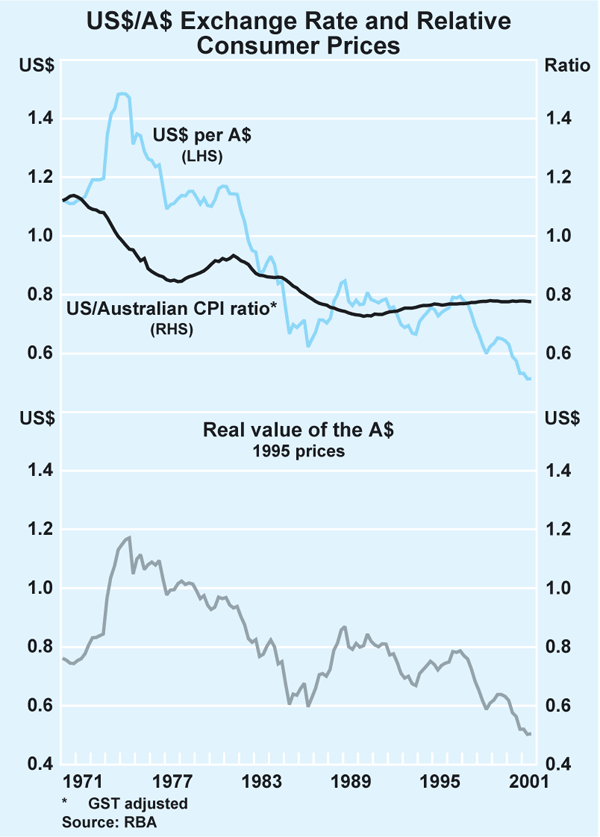
Since 1990, however, consumer prices have risen at roughly the same rate in Australia and the United States, so that inflation differences no longer make a contribution to explaining the continuing decline of the Australian dollar.
We can illustrate this point by focusing on the real value of the Australian dollar against the United States dollar, which is calculated by adjusting the market, or nominal, value of the exchange rate for differences in consumer price inflation. The real value of the Australian dollar has shown quite large swings over time, and in net terms has declined significantly over the 30 years since 1970, making it clear that there is more to the fall in the Australian dollar against the US dollar than simply a higher rate of inflation in Australia.
We can also conduct this analysis using a broader exchange rate measure, the trade-weighted index (TWI) of the Australian dollar (Graph 2). While the numbers change, the overall story remains similar. Over the two decades from 1970 to 1990, Australian consumer prices rose by a cumulative 38 per cent more than consumer prices in a weighted average of Australia's trading partners. This inflation differential would have been expected to lead to a decline in the Australian TWI from its 1970 index value of about 100 to about 72 by 1990, which can be compared to an actual average value of 57 in that year. Thus, a significant part, but by no means all, of the decline in the trade-weighted value of the Australian dollar over these two decades is explained by the higher average rate of inflation in Australia. Since 1990, however, this trend has turned around, and consumer prices have risen more slowly in Australia than the average of its major trading partners.
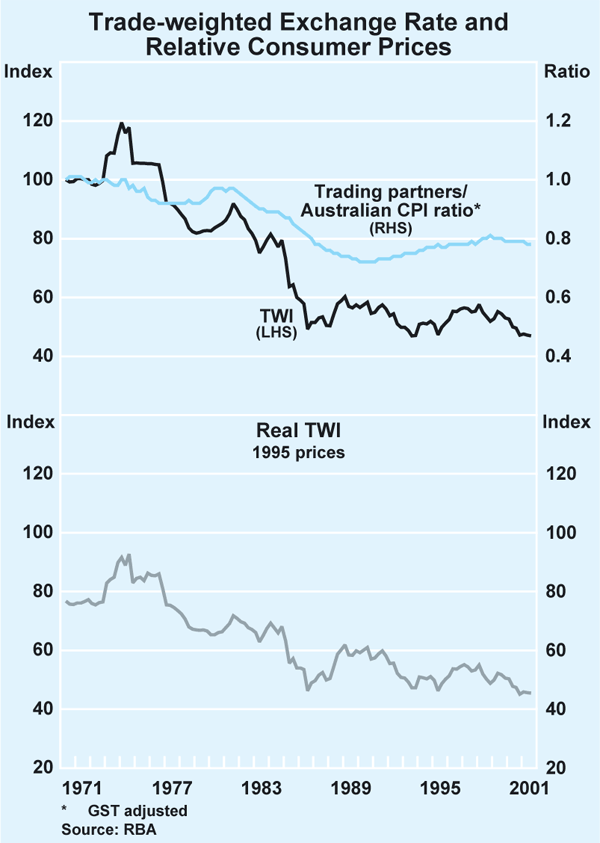
To summarise the point, then, higher inflation in Australia was an important factor explaining the trend decline in the Australian dollar for the two decades of the 1970s and 1980s. Since the early 1990s, however, with the significant decline in Australian inflation, and the introduction of the medium-term inflation target as the guiding principle for monetary policy, inflation rates in Australia have, if anything, been lower on average than in most of its trading partners.
Given the success of the inflation-targeting regime in Australia, and the bipartisan support for it, it seems plausible that the inflation experience of the 1990s provides a good guide for the future. If that is so, then it seems likely that any future trend declines in the Australian dollar, were they to occur, would not be driven by higher trend inflation in Australia. In other words, future trend declines in the market value of the Australian dollar, were they to occur, would constitute trend declines in its real value.
It is therefore of interest to examine the main longer-run determinants of the real exchange rate, and it is to these that I now turn.
The Terms of Trade
It has long been noted that the Australian real exchange rate, when measured in trade-weighted terms, moves quite closely with the terms of trade (that is, the ratio of export prices to import prices). Over the past 30 years, there have been big cycles in Australia's terms of trade; cycles which have usually been matched, at least roughly, by movements in Australia's real trade-weighted exchange rate index, or real TWI (Graph 3).
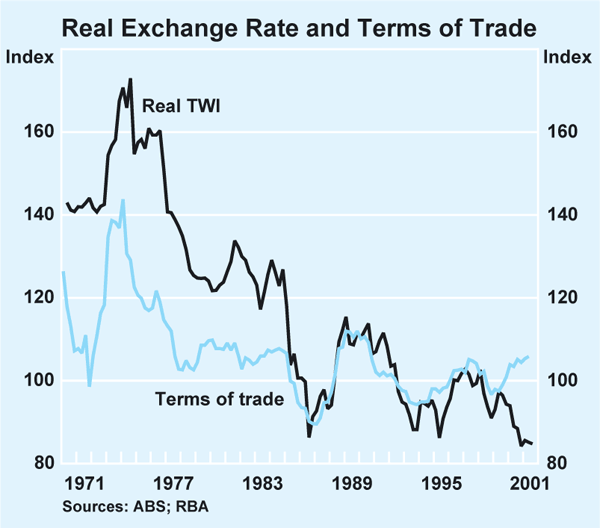
Rather than examining these cycles, however, I want to focus on the longer-term trends in the terms of trade, because it is these trends that are relevant to the longer-term behaviour of the Australian currency. As has been widely discussed, Australia has experienced a gradual trend decline in its terms of trade at least over much of the past forty years, and perhaps over the whole of the twentieth century.[2]
To get an idea of the average rate of decline of the terms of trade in the modern era, let me focus on the period from 1959, when quarterly national accounts data first became available, to 1985. The reason for excluding data after the mid 1980s will soon become apparent. Over the period to 1985, the terms of trade have declined at an average rate of about ¾ per cent per annum.[3] This rate of decline is a slow one, and it is often dominated by the terms-of-trade cycle from year to year. Over the longer run, however, it is the gradual downward trend that has dominated.
It is usually argued that this gradual downward trend in the terms of trade arises from the nature of Australia's exports. A large fraction of Australia's exports are commodities whose prices, although volatile from year to year, have been declining gradually relative to the prices of the manufactured goods that Australia imports.
Over more recent years, the share of commodities in Australia's export basket has also been declining gradually, from about three-quarters of goods and services exports by value in 1985, to about three-fifths in 2000. So one might expect that the effect on Australia's terms of trade of the declining relative price of commodity exports would be getting less important over time, simply because commodities are gradually becoming relatively less important as Australia's export base is diversified.
While this is undoubtedly true, a quite different development over the past 15 years or so is of much more importance, in terms of its effect on current and future trends in the terms of trade. That development is the gradually rising importance of information and communications technology (ICT) goods in the basket of goods that Australia imports.
ICT goods share some of the attributes of commodities. Some of the component parts of computers, like memory chips and hard disk drives for example, are relatively undifferentiated products, and are therefore more akin to commodities than most other manufactured goods. Furthermore, the prices of ICT goods are subject to significant swings, superimposed on a downward trend, much like the prices of other commodities. However, the downward trend in the price of ICT goods has been very rapid, as is clear from Graph 4; indeed, much more rapid than for other commodities, but its source is most probably the same.[4]
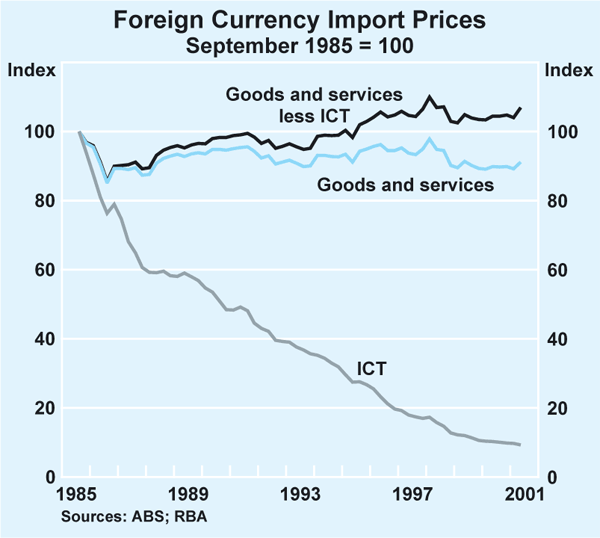
Although ICT goods account for only a small fraction of Australia's imports of goods and services (5 per cent by value in 1986, rising to 8½ per cent in 2000), their prices have been falling so rapidly that they have had a major favourable impact on the terms of trade. Had Australia imported no ICT goods over the past 15 years (or equivalently from the perspective of the terms of trade, had their prices behaved in the same manner as those for other imports) the Australian terms of trade would currently be around the same level as the trough that was reached in the mid 1980s, rather than being closer to the late-1980s peak (Graph 5). Over the past 15 years, the falling price of imports of ICT goods, taken in isolation from other trends, has raised the Australian terms of trade at an average rate of slightly more than 1 per cent per annum.
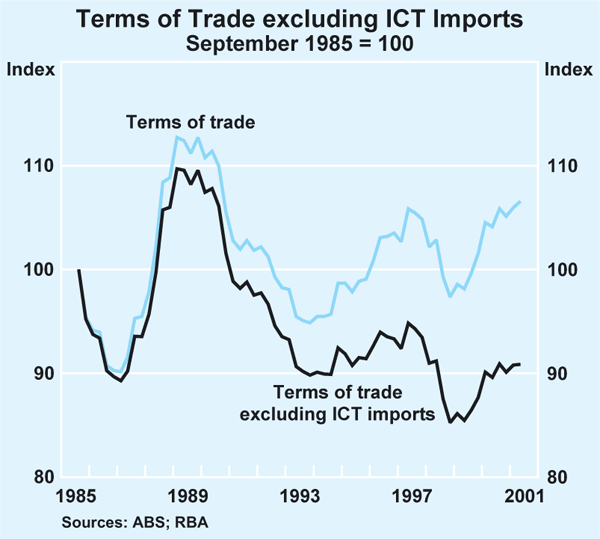
These developments augur well for Australia's terms of trade in the future. If current trends in both commodity export prices and ICT import prices continue, the long-run gradual decline of the terms of trade, evident over so much of the post-World War II era, is over. Indeed, if we take the numbers literally, and combine an annual trend rate of decline of ¾ per cent from commodity exports with a trend improvement of over 1 per cent from ICT imports, this suggests that the Australian terms of trade are now, and should in future, gradually trend upwards rather than declining.
The implications for the longer-run trends of the Australian dollar should also be clear. If the terms of trade trend up in the future, this should be associated, other things equal, with a gradually appreciating Australian real exchange rate, rather than the gradually depreciating real exchange rate that has been consistent with trend declines in the terms of trade in the past.
Productivity
A further relevant longer-run influence on exchange rates is developments in productivity. It is often argued that countries that have strong productivity growth have appreciating real exchange rates. And indeed this argument has a lot of empirical support. There are many examples of rapidly developing countries with strong productivity growth and appreciating real exchange rates. Thus, for example, over the 30 years from 1960 to 1990, when Japan was experiencing very rapid growth in labour productivity, the yen appreciated in real terms against the United States dollar by more than 200 per cent.
Countries that are experiencing rapid labour productivity growth and a trend appreciation of their real exchange rates must choose how to absorb this appreciation. One possibility is to hold domestic inflation at a desired rate and allow the nominal exchange rate to appreciate gradually, as the Singaporean authorities have done over many years. An alternative is to hold the nominal exchange rate fixed, as Hong Kong has chosen to do with its fix against the United States dollar since 1983. A corollary of this choice, however, is that the real exchange rate appreciation will manifest itself via a higher rate of price inflation in the economy experiencing high productivity growth than in the one with lower productivity growth. And that was indeed Hong Kong's experience, at least in the decade or so before the Asian financial crisis.
As is widely known, Australia has also experienced faster labour productivity growth than the United States. Because of the difficulties involved in measuring output in the public and some service sectors of the economy, measures of labour productivity are usually regarded as most reliable for the market sector, which makes up about two-thirds of the economy. Using this standard measure, labour productivity has been growing more strongly in Australia than in the United States for three decades, and especially since the beginning of the 1990s (Graph 6).
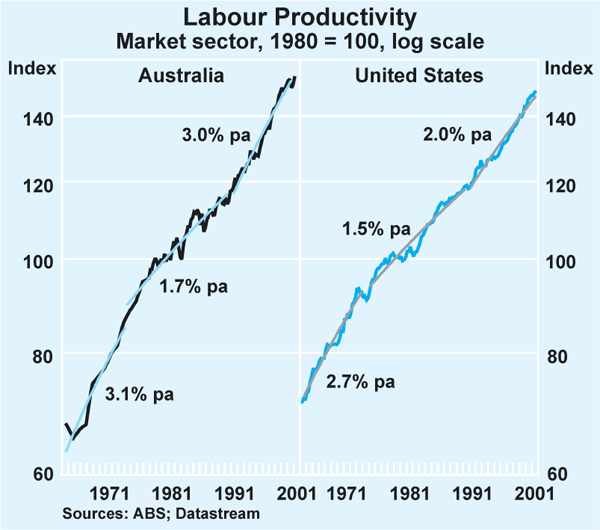
Can this faster productivity growth in Australia be consistent with a depreciating real exchange rate against the US dollar, rather than an appreciating one? The answer to this question is a qualified yes. It relies on the fact that the relationship between productivity growth and the exchange rate is more complex than the experiences of Japan, Singapore and Hong Kong would lead one to expect.
In each of these cases, the strong labour productivity growth was manifest predominantly in the manufacturing sector, which is part of the traded sector of the economy. In that case, strong productivity growth should, in theory, be associated with an appreciating real exchange rate – as has been the experience in Japan, Singapore and Hong Kong. Alternatively, however, if the strong productivity growth is predominantly in those industries that produce goods and services effectively shielded from international trade – the non-traded sector of the economy – then this presumption does not apply. Indeed, that sort of strong productivity growth should in theory be associated with a depreciating real exchange rate.
To see why, assume, for the moment, that Australia and the United States have the same rate of productivity growth in the traded sector of the economy, but that Australia has a higher rate of productivity growth in the non-traded sector than in the traded sector, while no such differential exists in the US. At a constant nominal exchange rate, the price of internationally traded goods will, of course, rise at the same rate in the two countries. In Australia, stronger labour productivity growth in the non-traded sector will translate, via competition for labour across the economy, to a slower rate of price growth for non-traded goods than for traded goods. And as a result, overall Australian domestic inflation – the combination of traded and non-traded inflation – would be lower than US inflation.
All other things equal, in this example, provided Australia is happy to run lower overall domestic inflation than the US, then there is no reason on trade grounds for the nominal exchange rate to change. However, if Australian monetary policy sought to keep overall Australian inflation at the same rate as in the US, the assumptions about productivity differentials above would be consistent with a declining nominal exchange rate. Of course, whatever the rate of Australian inflation, the Australian real exchange rate would be depreciating.
So the point is that in relating productivity to exchange rates, it is not the overall productivity differential between countries that matters; instead it is the comparison across countries of the productivity growth differentials between the traded and non-traded sectors of the economy.[5]
Looking specifically at the sectoral breakdown of productivity growth in the 1990s in the two countries, we see that labour productivity growth in the traded parts of the Australian market sector over the 1990s was significantly stronger than in the non-traded parts (Graph 7). But in the United States, the differential was even larger – labour productivity growth was much stronger in the traded parts of the US market sector than in the non-traded parts. This is largely a consequence of the very rapid productivity growth seen in the United States in the production of ICT goods, which was discussed earlier. These goods are, of course, internationally traded.
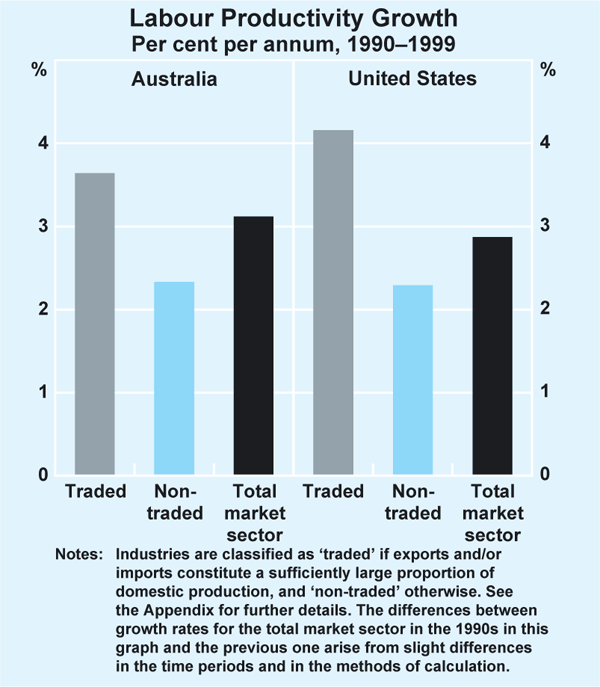
Based on these arguments, this difference in the pattern of productivity growth between the two economies is consistent with a small fall – about a 5 per cent fall – in the real value of the Australian dollar against the US dollar over the course of the 1990s.[6]
Having gone to all this trouble, however, it is pretty clear that this differential-productivity story explains only a small fraction of the depreciation of the Australian dollar over the past decade or so. Explaining a 5 per cent fall in the real value of the Australian dollar against the US dollar since 1990 doesn't get us very far in terms of the overall movement of this bilateral rate over this time (see Graph 1). Furthermore, it is not so easy to draw strong conclusions about the implications of differential productivity growth for the real trade-weighted value of the Australian dollar.[7]
Given the history of productivity trends, we should probably be pretty hesitant about extrapolating the 1990s productivity trends into the future. But if we were to do so, we would presumably anticipate a continued gradual trend decline in the real value of the Australian dollar, at least against the US dollar, and perhaps in trade-weighted terms.
The Foreign Asset Position
The last potentially important longer-term influence on the real exchange rate that I wish to discuss is the effect of Australia's changing foreign asset position. Analysis of the relationship between a country's foreign asset position and its real exchange rate has a distinguished history in economics, dating back at least to a 1920s debate between John Maynard Keynes and Bertil Ohlin about the economic implications of German reparations after the First World War.
It should be expected, other things equal, that the higher the level of a country's net foreign assets, the higher will be its real exchange rate – or to put it in a form more relevant to Australia's current situation, the higher the level of its net foreign liabilities, the lower its real exchange rate. To understand the reason for this relationship, remember that a country's foreign liabilities need to be serviced. To do so requires a more favourable balance of trade (if not currently then at some time in the future) than for a country with no foreign liabilities. To generate a more favourable balance of trade, in turn, requires a real depreciation of the exchange rate.[8]
Empirical analysis confirms a robust relationship between a country's net asset position as a ratio of its GDP and its real exchange rate (Lane and Milesi-Ferretti 2000).[9] So it is consistent with this analysis that, over the 1980s and 1990s, when the Australian current account deficit averaged about 4½ per cent of GDP, and net foreign liabilities rose from about one-fifth of GDP in 1980 to about three-fifths currently, this was associated with significant real depreciation of the Australian dollar.
In thinking through this issue, however, it is of interest to present the results of a simple counterfactual exercise. Had the Australian current account deficit averaged 4½ per cent of GDP not just for the decades of the 1980s and 1990s but indefinitely into the future, the stock of net foreign liabilities as a ratio to GDP would have risen gradually to a new higher level. The arithmetic of liability accumulation in a growing economy implies that net foreign liabilities would have risen from their current level of about three-fifths of GDP to an eventual level of, perhaps, three-quarters of GDP.[10]
Had this prospect eventuated, of course, downward pressure on the Australian real exchange rate would presumably have continued as the stock of foreign liabilities continued to rise gradually towards three-quarters of GDP.
But what has not been widely discussed is that, given the current stock of foreign liabilities – that is, about three-fifths of GDP – it is now the case that a current account deficit of about 3½ per cent of GDP will lead to no further change in the ratio of foreign liabilities to GDP, even if the current account deficit is sustained at that level indefinitely.[11] Indeed, a current account deficit sustained at less than 3½ per cent of GDP will lead to a gradual trend decline in the ratio of foreign liabilities to GDP.
Following the recent significant real depreciation of the Australian dollar, there has been a big fall in the current account deficit to levels around 2 per cent of GDP in the most recent quarters (Graph 8). It is not obvious, however, that this would be the current account outcome consistent with the present level of the exchange rate if the domestic and foreign economies were growing at their trend rates of growth. The current account deficit is, after all, sensitive to the state of domestic and foreign economic activity – and foreign activity has turned down sharply.
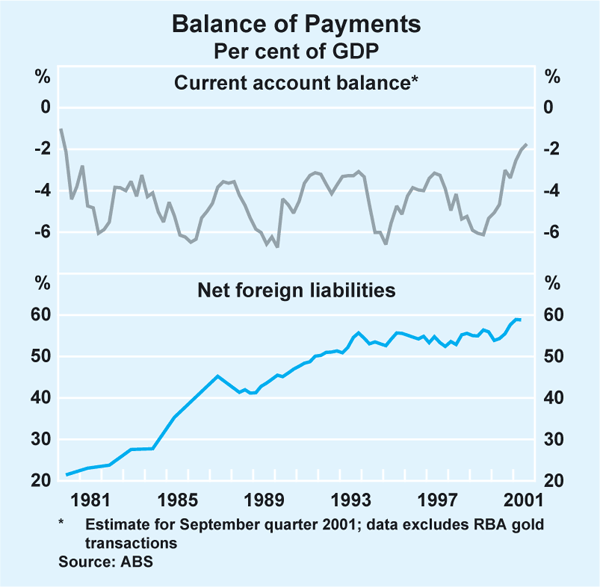
So we should not jump too quickly to the conclusion that the present level of the real exchange rate is consistent with a current account deficit that would be sustained at 2 per cent of GDP over the longer run. Nevertheless, it does seem plausible that the present level of the real exchange rate is consistent with a current account deficit sustained at less than 3½ per cent of GDP. If that is so, and if the exchange rate remains around its present levels at least on average, then we might expect that the ratio of net foreign liabilities to GDP would begin to gradually decline.
Just how fast the ratio should be expected to decline depends quite sensitively on the sustained level of the current account deficit.[12] Just as in the case of the terms of trade discussed above, however, a trend decline in the foreign liabilities to GDP ratio in the future, were it to occur, would represent a significant break with the past. And if the cross-country evidence on the link between foreign liabilities and the real exchange rate that was discussed above is any guide, a gradual trend decline in the ratio of foreign liabilities to GDP should be expected to put gradual upward pressure on the Australian real exchange rate in the years to come.
Concluding Remarks
Let me try to draw together the various strands of this talk. In thinking about the longer-term trends of the Australian dollar, I have focused on developments in four general areas: inflation, the terms of trade, productivity and Australia's foreign liabilities.
In a recurring theme, I have pointed to trends in the underlying economic data that have been apparent for much of the past several decades, but which have changed more recently, or which should be expected to change in the near future. In each case, the earlier trend was consistent with a gradual decline in the value of the Australian dollar, either in nominal or real terms. With a change in the trend, however, there should no longer be an expectation that the Australian dollar should continue to decline, at least not as a consequence of that particular economic influence.
To be more explicit, a higher trend rate of inflation in Australia than in the US or most of its other trading partners was evident over much of the 1970s and 1980s, and this inflation differential was consistent with a significant fall in the nominal value of the Australian dollar over these two decades. Since 1990, however, inflation in Australia has been roughly the same as in the US and somewhat lower than the average of Australia's trading partners. Higher inflation in Australia is thus no longer a reason for a trend decline in the Australian dollar.
On the terms of trade, a gradual long-term trend decline has been evident in the data for at least a quarter-century, from 1959 to the mid 1980s. Since then, however, the price of ICT imports has been falling sufficiently rapidly that this longer-term trend decline appears to be over, and may possibly have been replaced by a slight upward trend in the terms of trade.
On productivity, the story is somewhat more complex than one might at first suspect. It is the difference between labour productivity growth in the traded and non-traded sectors that is of relevance to the behaviour of the real exchange rate, rather than the economy's overall productivity performance. Developments in traded and non-traded productivity growth in Australia and the US in the 1990s are consistent with a gradual trend decline in the real bilateral value of the Australian dollar over that time. Looking to the future, there is no obvious reason to expect a change in these underlying trends.
On Australia's foreign asset position, the recent real depreciation of the Australian dollar has been associated with a significant narrowing in the current account deficit in 2001. If the real exchange rate remains around these levels, at least on average, then the gradual trend rise in Australia's net foreign liabilities to GDP ratio, which has been evident for the past two decades, should not be expected to continue. Instead, it may be replaced with a gradual trend decline in this ratio.
When it comes to exchange rates, it never pays to be dogmatic. Nevertheless, I hope that I have convinced you that there are some good grounds to suspect that the gradual trend decline of the Australian dollar, which has been evident for so much of the past few decades, may not continue into the future.
Ultimately, however, the influences that I have been discussing in this talk should be thought of as broad forces that tend to push the exchange rate in one direction or another over extended periods of time. But the puzzling behaviour of the Australian dollar over the past couple of years – not to mention the US dollar over much the same time – serves as a reminder that there is no close relationship between exchange rates and these longer-run economic fundamentals over these sorts of periods of time. So it is as well to recognise that it may take some time for these broad forces to have their expected effects, and that in the meantime, a myriad of other influences can hold sway.
Appendix
Trends in the terms of trade and commodity prices
The simplest approach to estimating the average trend rate of decline of the terms of trade is to fit a trend through the (log) terms of trade data. When this is done over the period, 1959:Q3–1984:Q4, the estimated average rate of decline is about ½ per cent per annum. However, it would seem appropriate to take into account the obvious cycles in the terms of trade. To do so, autoregressive models of the form:
 (A1)
(A1)
are estimated for k = 1, … 8, where tot is the log of the terms of trade for goods and services.
On the basis of both Akaike and Schwarz information criteria, the best model is the
one for k = 8. This model fits the data well, with  . The downward trend is highly significant, and it implies
a long-run trend rate of decline (given by
. The downward trend is highly significant, and it implies
a long-run trend rate of decline (given by  per cent per annum.
per cent per annum.
I can check the plausibility of this number by estimating the longer-run trend in the foreign-currency price of Australia's commodity exports. Applying the same methodology, autoregressive models (k = 1, … 12) are estimated, for the log of the monthly Reserve Bank commodity price index in SDR over the period over which data are available, July 1982 to October 2001. The two information criteria suggest different ‘best’ models (Akaike suggests k = 12; Schwarz k = 2). Either way, the long-run trend rate of decline for commodity prices is estimated to be about 1½ per cent per annum. Since commodities account for about half of Australia's exports of goods and services, their contribution to the trend decline in Australia's terms of trade for goods and services would therefore be about ½×1½ = ¾ per cent per annum, i.e., the same estimate as the one derived from the terms of trade data over the earlier sample period.
The contribution of ICT import prices to the terms of trade
The Törnqvist index is used to remove ICT import prices from the implicit price deflator (IPD) for goods and services imports. The methodology is an adaptation of Fox and Kohli (1998). In the Törnqvist index, the changes in component prices (Pn) are geometrically weighted by the arithmetic average of their last period and current period share in total value (sn,t + sn,t−1) to calculate an aggregate price, where the subscript n refers to any component of the index (subscripts i and h are used in an equivalent fashion below). To enhance accuracy, an imports IPD less ICT (pN) has been calculated by removing the ICT IPD from the goods and services imports IPD:
 (A2)
(A2)
where

Pi is the goods and services imports IPD, Ph is the ICT IPD (itself a Törnqvist index of IPDs for automated data processing (ADP) equipment, communications equipment and parts for ADP equipment), and the value weights, si and sh, are calculated as a proportion of the value of goods and services imports less ICT.
Productivity calculations: sectoral analysis
Industries in the Australian market sector are allocated to the traded sector if the ratio of either exports or import-competing goods to total industry supply exceeds 10 per cent. The classification uses industry-of-origin classification codes, which cover 109 Australian industries. The relevant data for this allocation are sourced from 1994/95 Australian input-output tables. On this basis, the traded sector comprises agriculture, mining, air transport, water transport and manufacturing other than wood and paper products, printing and publishing, and non-metallic minerals manufacturing. The non-traded sector comprises the manufacturing sub-sectors excluded from the traded sector, construction, utilities, wholesale and retail trade, transport and storage other than air and water transport, communications, accommodation cafés and restaurants, finance and insurance, and cultural and recreational services. All other sectors of the economy are non-market sectors for which labour productivity data cannot be calculated independently.
For the United States, industries in the market sector are allocated as traded or non-traded to match the Australian classifications as closely as possible. On this basis, the US traded sector comprises agriculture, forestry etc, mining, water transportation, transportation by air, and manufacturing other than lumber and wood products, furniture and fixtures, stone, clay, and glass products, paper and allied products, and printing and publishing. The US non-traded sector comprises the manufacturing sub-sectors excluded from the traded sector, construction, transportation & public utilities excluding water transportation and transportation by air, wholesale trade, retail trade, ‘finance, insurance and real estate’ less real estate, hotels and other lodging places and amusement and recreation.
The appreciation of the Australian/US bilateral real exchange rate, RER, consistent with the observed sectoral productivity developments is then:
 (A3)
(A3)
where, for each economy, α is the share of non-traded goods and GAP is the gap between labour productivity growth in the traded and non-traded sectors (see Tille et al (2001) for a derivation of the equation). Over the period 1990 to 1999, the relevant values for the market sectors for the two economies are αAUS = 0.67, GAPAUS = 1.6 per cent per annum, αUS = 0.69, and GAPUS = 2.2 per cent per annum, which is consistent with a depreciation of the Australian/US bilateral real exchange rate of about ½ per cent per annum, or about 5 per cent over the decade of the 1990s.
It should be noted that this calculation assumes that the characteristics of the non-market sectors of the two economies are the same as those of the market sectors. The relevant characteristics are the relative sizes of the traded and non-traded parts of the non-market sector, and the productivity differential between those parts. Alternative assumptions would produce different estimates, but the general point would remain that the pattern of productivity growth across the two economies is consistent with a small depreciation in the real value of the Australian dollar over the 1990s.
Endnotes
I am very grateful to Ellis Connolly, Luci Ellis and Kenneth Leong for their help in preparing this talk. The views expressed are those of the author and not necessarily those of the Reserve Bank of Australia. [1]
Annual data on Australia's terms of trade from 1900 to 1973 are available from Butlin (1977). These data exhibit much volatility, and also show a hint of a slight downward trend. This hint, however, is not sufficient to survive formal statistical tests, which suggest that the trend is statistically insignificant. [2]
The Appendix explains how this number is estimated. It is worth recording in passing that the gradual trend decline in the measured terms of trade may be a statistical artefact, at least to some extent. It is usually argued that statistical agencies do not capture all of the quality improvements in the kind of differentiated products that Australia imports. If that is so, then the ‘true’ rate of price increase for these goods is over-estimated. Since price indexes for Australia's commodity exports are less susceptible to these problems (because, for example, the quality of a ton of coal does not change much from one decade to the next) the rate of decline in the measured terms of trade series is probably faster than its true rate of decline. [3]
That source is rapid labour productivity growth. Labour productivity growth has been extremely rapid in the production of ICT goods (Oliner and Sichel 2000), and it has also been rapid in the production of other commodities. Thus, for example, labour productivity growth in the Australian mining sector, which produces a good proportion of Australia's commodity exports, has exceeded 5 per cent per annum on average over the past two decades. I will return to the issue of productivity in the next section. [4]
This point was originally made by Balassa (1964) and Samuelson (1964). In the case of Japan, discussed earlier, it was both the strong productivity growth in the traded (mainly manufacturing) sector and the quite poor productivity performance in many non-traded parts of the economy that were jointly responsible for the appreciating real value of the yen over much of the post-World War II period. A corollary to this argument is that a significant improvement in productivity levels in the non-traded parts of the Japanese economy would likely be associated with a real depreciation of the yen, even though it would also undoubtedly improve the overall living standards of the Japanese. This is an example of the general point that changes in a country's exchange rate are not a good guide to developments in its citizens' overall living standards, notwithstanding frequent claims to the contrary. [5]
See the Appendix for further details. [6]
For Japan and the Euro area, the traded/non-traded productivity gap over the 1990s was much smaller than for the United States (Tille, Stoffels and Gorbachev 2001). Based on these data, therefore, it is not clear that the observed productivity differentials imply any real depreciation of the Australian dollar against these trading partners' currencies. On the other hand, it seems plausible that trend productivity growth in the traded sectors of non-Japan Asian trading partners has been more rapid than in their non-traded sectors, and hence that real depreciation of the Australian dollar against these currencies would be justified on these grounds. [7]
It also requires an adjustment in the country's saving/investment balance (see Krugman (1989) for further discussion). To simplify the exposition, I do not discuss the timing of the real depreciation, which would depend on the extent to which the present value of the exchange rate embodies the market's beliefs about the path of external liabilities out into the future. [8]
Interestingly, the real exchange rate sensitivity to changes in net asset position seems quite modest. Lane and Milesi-Ferretti's results imply that a rise in a country's net foreign assets of 10 per cent of GDP is associated, on average, with a real appreciation of about 3 per cent in the longer run. [9]
If the current account deficit to GDP ratio is running at a constant rate cad, and nominal GDP is growing at a constant rate g, then the ratio of foreign liabilities to GDP eventually asymptotes to cad/g. With Australian nominal GDP growing at a trend rate of about 6 per cent per annum (real growth of 3½ per cent, and inflation of 2½ per cent), a steady current account deficit of 4½ per cent of GDP will eventually generate a stock of foreign liabilities of 4½/6 = ¾ of GDP. On the speed of adjustment, note that after a decade, the foreign liabilities to GDP ratio would have risen slightly less than half way to its long-run level, from about 0.60 to about 0.67. [10]
Applying the analysis from the previous footnote, a current account deficit of 3½ per cent of GDP will generate a stock of net foreign liabilities in the long run of 3½/6 = 0.58, or about three-fifths of GDP. [11]
A couple of examples illustrate the sensitivity. With nominal GDP growth of 6 per cent per annum, and an initial stock of foreign liabilities of 60 per cent of GDP, a sustained current account deficit of 2 per cent of GDP will generate a fall in the foreign liabilities to GDP ratio to 48 per cent after a decade, and 33 per cent in the long run. For a sustained current account deficit of 3 per cent of GDP, the corresponding figures are 56 per cent after a decade, and 50 per cent in the long run. [12]
References
Balassa B (1964), ‘The Purchasing-Power Parity Doctrine: A Reappraisal’, Journal of Political Economy, 72, pp 584–596.
Butlin MW (1977), ‘A Preliminary Annual Database 1900/01 to 1973/74’, Reserve Bank of Australia Research Discussion Paper No 7701.
Fox KJ and UR Kohli (1998), ‘GDP Growth, Terms-of-Trade Effects, and Total Factor Productivity’, The Journal of International Trade and Economic Development, 7(1), pp 87–110.
Krugman PR (1989), Exchange-Rate Instability, The MIT Press, Cambridge.
Lane PR and GM Milesi-Ferretti (2000), ‘The Transfer Problem Revisited: Net Foreign Assets and Real Exchange Rates’, International Monetary Fund Working Paper No 00/123.
Oliner SD and DE Sichel (2000), ‘The Resurgence of Growth in the Late 1990s: Is Information Technology the Story?’, The Journal of Economic Perspectives, 14(4), pp 3–22.
Samuelson PA (1964), ‘Theoretical Notes on Trade Problems’, Review of Economics and Statistics, 46, pp 145–154.
Tille C, N Stoffels and O Gorbachev (2001), ‘To What Extent Does Productivity Drive the Dollar?’, Federal Reserve Bank of New York, Current Issues in Economics and Finance, 7(8).